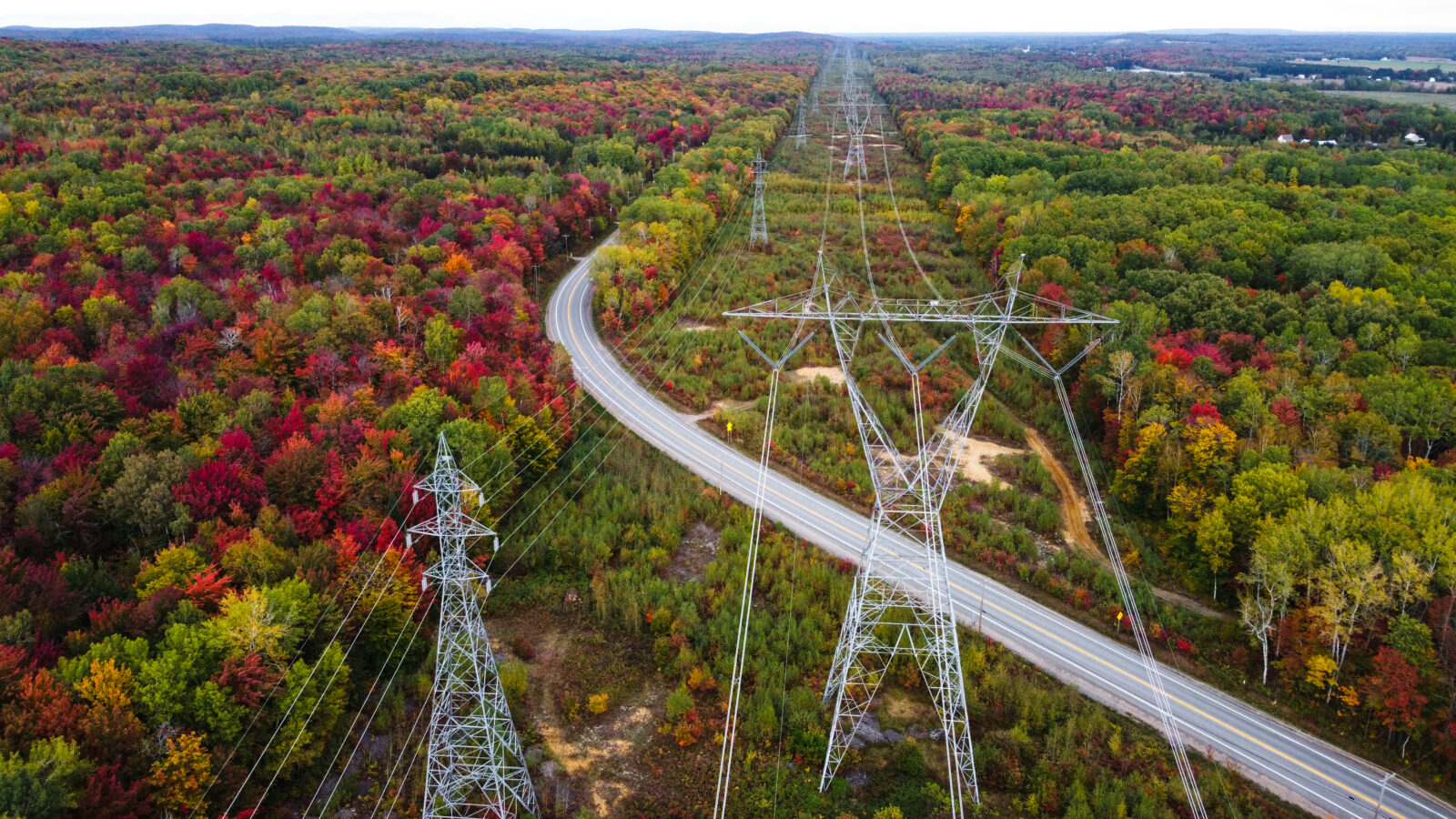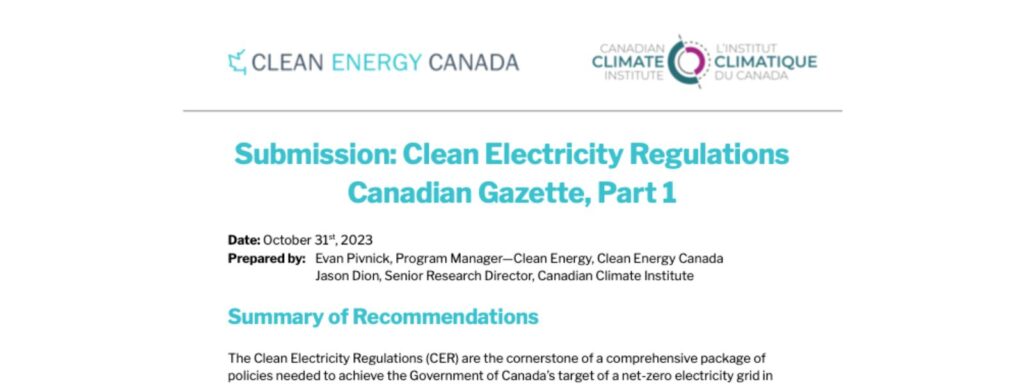See also our August 2023 blog, Five things to watch for in the Clean Electricity Regulations.
On August 10, the government of Canada released its long-anticipated draft Clean Electricity Regulations, giving us our first comprehensive look at the new policy, including more insight into its context, design, and implications. This blog is the first in a two-part series exploring the regulations. It digs into their key provisions, explores the trade-offs they seek to balance, and explains how they will move our grid towards net zero electricity by 2035. Part two will turn to the related policies that the Clean Electricity Regulations work alongside, and how Canada can address the electricity sector emissions that will remain after 2035.
The importance of these draft regulations can’t be understated. They represent a significant step towards delivering on the government’s commitment to a net zero electricity grid by 2035, which is crucial for meeting Canada’s emissions reduction targets and accelerating Canada’s energy transition to net zero economy-wide by 2050.
These regulations are part of a broader package of policies the federal government has already put in place or has been rolling out to support the deployment of clean electricity, including numerous measures announced in Budget 2023, and all guided by an overarching electricity vision that was also released in August.
Canada’s Clean Electricity Regulations come at a critical time. Escalating wildfires, flooding, and other consequences of climate pollution around the world underscore the urgency of rapidly decarbonizing our economies. Evidence from numerous studies, ranging from the International Energy Agency to Canada’s Energy Regulator, points to the fact that a cost-effective transition to a net zero economy by 2050 depends upon having a clean electricity grid ahead of that date. Other countries — including the United States and the rest of the G7 — understand this as well and have similarly committed to a net zero electricity grid by 2035. Simply put, clean electricity is the foundation upon which the entire energy transition is built. Clean cars, clean industries, clean homes: all of them need clean electricity.
Debates on these topics need to be grounded in facts, rather than inaccurate assertions about the regulations and their impact. So let’s unpack some of the details of what’s actually being proposed in the draft Clean Electricity Regulations.
How the proposed Clean Electricity Regulations work
The regulations are based around the creation of a near-zero emissions standard for fossil -powered electricity generation, as well as several important compliance flexibilities to help manage a transition, that together would still allow some emissions past 2035. Fundamentally, this means that while the Clean Electricity Regulations play a critical role in propelling the country’s grid towards net zero by 2035, they do not, on their own, get us all of the way there.
Under the proposed regulations, the electricity sector in 2035 will still be allowed to release low amounts of residual emissions, which will need to be reduced or offset by other policies and measures in order to achieve the target of a net zero grid. These additional measures could include both carrots and sticks: strengthened carbon pricing to further incentivize emissions reductions, funding to build new non-emitting electricity generation, and potentially other measures to offset remaining emissions (which we’ll discuss in the second part of this blog series).
The fact that there are likely to be emissions remaining in 2035 after the application of the standard was a deliberate design choice to help ensure grid reliability. The regulations are also largely technology-neutral, leaving provinces to choose how they want to plan and build their systems in response to the regulation, as these governments are ultimately responsible for the design and operation of electricity systems. This approach strikes a balance between driving emissions reductions and ensuring reliability and cost-effectiveness — all while respecting provincial jurisdiction.
Digging into the details
As mentioned above, the draft regulations include a variety of measures that will help drive down emissions while also allowing for flexibility that will support system reliability and cost-effectiveness. As the regulations get finalized, striking the right balance for these measures will be essential. Below we dig into some of the most impactful measures that have been advanced, providing both context and a preliminary assessment of their implications.
Performance standard
The first, and perhaps most fundamental, element of these new regulations is the performance standard it establishes for electricity generators. By 2035, any electricity generating facility that uses fossil fuels to generate 25 megawatts or more of electricity, and that sends more electricity to the grid than it draws, must not emit more than 30 tonnes of carbon dioxide equivalent per gigawatt hour (CO2e/GWh) as an average over a calendar year.
By choosing to use a higher-than-zero threshold for emissions, the government has sought to balance the need to make this regulation technology neutral (by maximizing the range of technologies that provinces could choose to meet the standards) with the need to achieve meaningful emissions reductions. At first glance, a standard of 30 tonnes of CO2e/GWh looks to have achieved this balance. The proposed level of stringency would require roughly a 90-to-95 per cent carbon capture rate for fossil gas facilities. Attempting to impose a more stringent standard could have significant impacts on cost, with only a marginal impact on emissions. Furthermore, carbon capture and storage (CCS) technology would likely struggle to achieve a higher capture rate than what is proposed.
Recognizing that it may take time to troubleshoot the application of CCS technology in gas-fired facilities, the government has also introduced a provision that allows a facility that has deployed a CCS system to emit slightly more emissions for a slightly longer period of time beyond 2035. The government designed this measure to reduce the uncertainty that faces first-generation CCS technology, but has suggested that CCS would likely be sufficiently mature by 2040 that the exception could be phased out at that time.
While we should be extremely cautious of relying too much on untested CCS technology to achieve the emissions reductions required, there is no question that it will have a role to play. It therefore makes sense to write into the regulations an exception that helps decrease the risks associated with deploying the technology, as well as ensuring that system operators can continue to provide electricity from these units during the adjustment period.
To summarize: the performance standard incentivizes either non-emitting generation or heavily abated fossil gas by 2035, while leaving runway for CCS technology to further develop. This ensures that provinces can still look to fossil gas to play a role where necessary, but that they do so in a way that delivers meaningful emissions reductions.
Old vs. new units and understanding the end-of-prescribed-life conditions
Importantly, the proposed performance standard doesn’t immediately apply to all facilities at the same time. Instead, the regulations create distinct categories that face different timelines for meeting the standard, often based on their “commissioning date” (the date upon which the facility first begins to operate). The most significant division is between “new units” and “existing units.”
“New units”
Any unit that comes into operation after January 1, 2025, will be required to meet the performance standard by January 1, 2035. Given that a fossil gas facility typically operates for at least 40 years, this requirement will create planning certainty for utilities and project developers that any fossil gas that comes online after January 1, 2025, must also utilize CCS technology or be CCS-ready by 2035. This gives “new” fossil gas units, as defined in the regulations, only a decade or less to operate prior to facing the performance standard.
There’s no question that fossil gas will continue to play a role beyond 2035 on our electricity grid. But to the greatest extent possible, that gas must be abated, and utilities and project developers need to start treating unabated fossil gas as a last resort. It’s critical, therefore, that we examine whether the regulations provide a strong enough signal to disincentivize the construction of new unabated fossil gas units, while also incentivizing the development of new non-emitting sources. Otherwise, the continued construction of new fossil gas plants (those commissioned after January 1, 2025), which would not require CCS technology until 2035, could have the effect of backloading emissions reductions and placing pressure on future governments to weaken the regulations.
“Existing units” and end of prescribed life
Existing units, which are defined as facilities that were commissioned before January 1, 2025, won’t necessarily be required to meet the performance standard by 2035. Instead, they are expected to align by whichever date occurs later: January 1, 2035, or “following the unit’s end of prescribed life,” which is defined as 20 years after its commissioning date.
That means that a facility that started operation before 2015 would be subject to the performance standard immediately in 2035, while one commissioned in 2024 would be permitted to operate outside the standard until 2044.
There’s an important tradeoff here. On one hand, creating a phaseout period for “existing” fossil gas units provides some important benefits. First, this approach stretches the potential costs and grid impacts of removing or upgrading these units over a longer timeline. This helps ensure that the transition can be orderly, with time for planning to resolve grid impacts and accessing forecasted price declines in emerging alternative technologies, like battery storage and enhanced geothermal. Second, existing facilities may face higher costs to retrofit with CCS technology, given that they were never designed with that in mind. This will require thoughtful planning and a longer timeline to either remove units for upgrading, or procure new resources to replace them. In either case, a transition period may be warranted.
On the other hand, providing too long a transition period risks entirely undermining the intent of the regulations by disincentivizing the transition to non-emitting sources of electricity and terminally delaying the emissions reductions that need to be achieved. Indeed, the government’s models found that allowing “existing units” to operate for 25 to 30 years saw both costs go up and emission reductions go down.
In short, while an end-of-prescribed-life provision is an understandable flexibility provided to provinces to ensure an orderly and cost-effective transition, the impact of a 20-year grace period should be assessed carefully, and extension beyond the current 20 years should not be considered.
Exception for fossil gas flexibility
Another significant exception to the standard allows for the operation of fossil gas facilities outside of the performance standard for short periods of time over the course of a year. Specifically, the Clean Electricity Regulations propose allowing fossil gas units to emit up to 150 kilotonnes of CO2 per year and operate for up to 450 hours/year. This roughly equates to a facility operating for around 5 per cent of the total hours of the year at 100 per cent capacity.
In practice, this is intended to create a role for fossil gas peaker plants — dispatchable electricity units that are kept as a backup and can be brought online quickly to help address periods of high demand or to balance variable production from renewables.
There will be a lot of debate regarding this provision.
On the one hand, using both a non-zero performance standard, and including exceptions like this, which provides an ongoing role for unabated fossil gas, makes the challenge of achieving a net zero electricity grid by 2035 more challenging.
On the other hand, there’s merit to the argument that retaining a limited amount of system back-up — even in the form of unabated fossil gas — may be warranted to support a transition to a non-emitting system. Given the size and cost of the build out of non-emitting power required to meet even the average annual system needs, permitting a small amount of emitting generation that is highly deployable (can be turned on and off at short notice) can help provide reliability in an affordable manner while we work to transition our energy systems to 100 per cent non-emitting sources. And these emissions would still be subject to the carbon price, providing further incentive to only operate these resources when they are actually needed.
Furthermore, it’s worth noting that not all regions of Canada face the same challenges — or are starting from the same point. Jurisdictions like Alberta, Saskatchewan, and parts of the Maritimes still heavily rely on fossil fuels for their power generation. In addition to requiring a more sweeping transition, they can also face colder temperatures with high energy demand for heating in the winter. While non-emitting technologies — including energy storage — are quickly becoming cost competitive, providing an exception that allows a limited role for fossil gas-based backup is warranted as these resources are being built out and properly integrated.
One of the key questions that will be debated is whether 450 hours provides an adequate limit to meet these system needs. A first issue is whether that kind of utilization rate is sufficient to ensure system reliability, and whether it provides an appropriate weighting of emissions reductions versus cost. In the government’s modeling, an 8-10 per cent utilization rate saw a marginal decrease in costs of between 1 and 3 per cent but a 4 to 15 per cent increase in emissions. The second issue is whether operating for this period provides adequate financial incentives for companies in each jurisdiction to keep gas capacity online. Given important differences between provinces, including market structure, weather, and current share of fossil-based power, there will be different calculations.
For instance, in Alberta, where an exception for peaker plants may be especially important, the combination of a liberalized energy market, the lack of a dedicated capacity market, and a cap of $1,000 per megawatt hour may mean that 450 hours does not provide enough incentive to maintain a peaking facility. Whether this is predominantly a provincial market design challenge or a federal regulatory design challenge is an important question, but there’s no doubt the policy needs to achieve emissions reductions without undermining the reliability or affordability of the grid.
Capturing all generators, including cogeneration facilities
Another major policy decision that will be hotly debated is the inclusion of cogeneration facilities — facilities that are used to generate both heat and electricity at the same time. The new regulations would impose the performance standard on any facility that has net exports to the electricity grid (more electricity provided to the grid than used from the grid) over the course of a year.
Cogeneration is used in a number of different industries across Canada but particularly in the oil and gas sector. While this element of the policy could have some impact on certain facilities and sectors, the inclusion of the 25-megawatts minimum for a facility to be captured by the regulations, as well as the requirement that a facility be a net exporter of electricity to the grid over a year, will likely limit the unintended capturing of primarily non-electricity sector cogeneration.
Its inclusion in the Clean Electricity Regulations is particularly noteworthy from an emissions perspective, however. Roughly 28 per cent of Alberta’s electricity is generated from cogeneration, accounting for approximately 19 megatonnes of greenhouse gas emissions from the province. Failing to include cogeneration could risk creating a loophole that incentivized the deployment of unabated cogeneration units that wouldn’t be subject to the new regulations. The final regulations will need to clearly delineate which cogeneration facilities across the country are captured by the regulations, and what impacts that inclusion or exclusion may have on other industries.
Looking beyond the Clean Electricity Regulations
In order to properly understand how the Clean Electricity Regulations operate — and the potential impacts they will have — it is essential that the implications of these and other specific design choices are well understood. Our detailed submission to the government’s consultation process will get into greater detail about these trade offs, where we see the right balance being struck, and where some adjustments may be required.
However, it is impossible to fully consider the utility of the Clean Electricity Regulations without also discussing the other policies that must work in conjunction with them to accelerate Canada’s clean energy transition. In particular, we must consider both how carbon pricing will be applied in the electricity sector, and how residual emissions will be dealt with. We dig into both of these in the second part of this blog series.
Evan Pivnick is Clean Energy Program Manager with Clean Energy Canada. Jason Dion is Senior Research Director with the Canadian Climate Institute.









